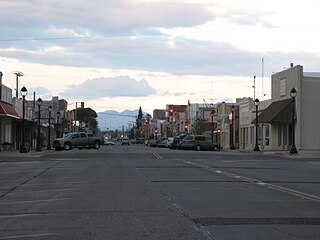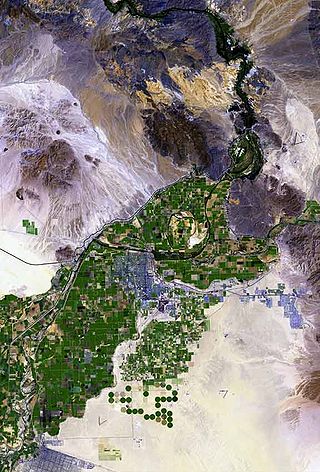
Arizona State University is a public research university in the Phoenix metropolitan area, Arizona, United States. Founded in 1885 as Territorial Normal School by the 13th Arizona Territorial Legislature, the university is one of the largest public universities by enrollment in the United States. It was one of about 180 "normal schools" founded in the late 19th century to train teachers for the rapidly growing public common schools. Some closed, but most steadily expanded their role and became state colleges in the early 20th century, then state universities in the late 20th century.

Graham County is a county in the southeastern part of the U.S. state of Arizona. As of the 2020 census, the population was 38,533, making it the third-least populous county in Arizona. The county seat is Safford.

Safford is a city in Graham County, Arizona, United States. According to the 2020 Census, the population of the city is 10,129. The city is the county seat of Graham County.

Thatcher is a town in Graham County, Arizona, United States. According to the 2010 Census, the population of the town is 4,865. It is part of the Safford Micropolitan Statistical Area.

Appalachian State University (; is a public university in Boone, North Carolina. It was founded as a teachers' college in 1899 by brothers B. B. and D. D. Dougherty and the latter's wife, Lillie Shull Dougherty. The university expanded to include other programs in 1967 and joined the University of North Carolina System in 1971.

Lawrence University is a private liberal arts college and conservatory of music in Appleton, Wisconsin, United States. Founded in 1847, its first classes were held on November 12, 1849. Lawrence was the second college in the U.S. to be founded as a coeducational institution.

The University of Louisville (UofL) is a public research university in Louisville, Kentucky, United States. It is part of the Kentucky state university system. Chartered in 1798 as the Jefferson Seminary, it became in the 19th century one of the first city-funded public colleges in the United States. The university is mandated by the Kentucky General Assembly to be a "Preeminent Metropolitan Research University".

The State University of New York at Buffalo is a public research university with campuses in Buffalo and Amherst, New York, United States. The university was founded in 1846 as a private medical college and merged with the State University of New York system in 1962. As of 2022, it is one of two flagship institutions of the SUNY system, along with Stony Brook University. As of fall 2020, the university enrolled 32,347 students in 13 schools and colleges, making it the largest public university in the state of New York.

The University of Baltimore is a public university in Baltimore, Maryland. It is part of the University System of Maryland. UBalt's schools and colleges provide education in business, law, public affairs, and the applied arts and sciences. The university is the location of one of Maryland's two law schools.

Northern Arizona University (NAU) is a public research university based in Flagstaff, Arizona. Founded in 1899, it was the final university established in the Arizona Territory.

Northern Illinois University (NIU) is a public research university in DeKalb, Illinois. It was founded as Northern Illinois State Normal School in 1895 by Illinois Governor John P. Altgeld, initially to provide the state with college-educated teachers. In addition to the main campus in DeKalb, it has satellite centers in Chicago, Naperville, Rockford, and Oregon, Illinois.

Mesa Community College (MCC) is a public community college in Mesa, Arizona. It is the largest of the 10 community colleges in the Maricopa County Community College District, the largest community college district in the United States in terms of enrollment.

Texas A&M University–Kingsville is a public research university in Kingsville, Texas. It is the southernmost campus of the Texas A&M University System. The university developed the nation's first doctoral degree in bilingual education. It is classified among "R2: Doctoral Universities – High research activity" and accredited by the Southern Association of Colleges and Schools (SACS).

Safford High School, of the Safford Unified School District, is one of two public high schools in Safford, Arizona. The campus hosts the Safford Center for the Arts, located on the north lot of the campus property.

The Gila River Valley is a multi-sectioned valley of the Gila River, located primarily in Arizona. The Gila River forms in western New Mexico and flows west across southeastern, south-central, and southwestern Arizona; it changes directions as it progresses across the state, and defines specific areas and valleys. The central portion of the river flows through the southern Phoenix valley region, and the final sections in southwestern Arizona form smaller, irrigated valleys, such as Dome Valley, Mohawk Valley, and Hyder Valley.

Central is a census-designated place in Graham County, Arizona, United States. Its population was 758 as of the 2020 census. It is part of the Safford micropolitan area.

The Gila Valley Arizona Temple is a temple of the Church of Jesus Christ of Latter-day Saints in the town of Central between the communities of Pima and Thatcher in Arizona. The temple was dedicated on May 23, 2010, following an open house lasting from April 23 to May 15.
The Black Hills of Greenlee County are a 20 mi (32 km) long mountain range of the extreme northeast Sonoran Desert bordering the south of the White Mountains of eastern Arizona's transition zone.

Gila Community College (GCC) is the community college serving the Gila Community College District in Gila County, Arizona. It has two campuses:
- Gila Pueblo Campus, Globe, Arizona
- Payson Campus, Payson, Arizona


















